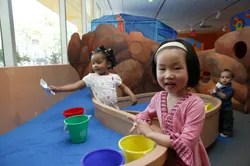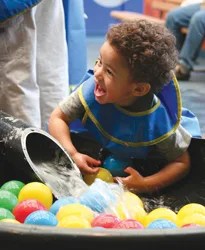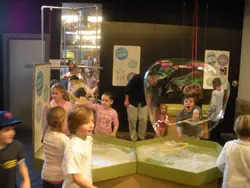Children’s museums encourage a child’s natural curiosity
 Five-year-old Kate Cleary of Long Island loves everything about insects. She knows quite a lot about the world of creepy crawlers for a girl her age, and she wants to know more. But since bugs aren’t part of the usual kindergarten curriculum-except maybe the anthill by the sandbox-Kate might have had to learn about her favorite critters on her own time, or simply wait a few years in the hopes that her middle school science class would spend a few days on the subject. During a recent visit to the Long Island Children’s Museum, though, Kate happened to meet Dawn Weiss, the museum’s exhibit developer. Their conversation led to a one-on-one interview all about Kate’s infatuation, which became the inspiration for a new insect exhibit at the museum that’s now in the planning stages.
Five-year-old Kate Cleary of Long Island loves everything about insects. She knows quite a lot about the world of creepy crawlers for a girl her age, and she wants to know more. But since bugs aren’t part of the usual kindergarten curriculum-except maybe the anthill by the sandbox-Kate might have had to learn about her favorite critters on her own time, or simply wait a few years in the hopes that her middle school science class would spend a few days on the subject. During a recent visit to the Long Island Children’s Museum, though, Kate happened to meet Dawn Weiss, the museum’s exhibit developer. Their conversation led to a one-on-one interview all about Kate’s infatuation, which became the inspiration for a new insect exhibit at the museum that’s now in the planning stages.
Behind the colorful displays and interactive elements that characterize children’s museums, there are people like Weiss, whose goal it is to ensure that each new exhibit is engaging, educational, and hopefully entertaining. Therefore, the next step in the process, Weiss says, is to gather a group of kids like Kate and start picking their little brains. This type of focus group is a common way for Weiss and her staff to begin planning an exhibit. “I want to know what kids know, what they understand, and what they misunderstand about a subject,” Weiss says. “I listen to the questions they have, I get them to talk to one another and answer each other’s questions, and then I see where I need to fill in the gaps.” After that, Weiss says, she’ll call in the experts on the subject, and that’s when the exhibit idea will really start to take shape.
“The questions that children have are very different from adults’ questions. We need to start where they are and understand the world from their perspective.” -Dawn Weiss, exhibit developer at the Long Island Children’s Museum
 Most children’s museums cater to kids between the ages of birth and 12 years old. The ability to offer something for everyone in that age category is the most important qualification for a new exhibit, says Liza Reich Rawson, senior exhibition developer and project manager at the Brooklyn Children’s Museum. “Children are a wide and varied audience,” Rawson says. “The 4-year-old walking through our door is not the same as a 10-year-old. When we’re organizing an exhibit, we think about what children are like and what they need-socially, physically, and cognitively-at each stage of their development.”
Most children’s museums cater to kids between the ages of birth and 12 years old. The ability to offer something for everyone in that age category is the most important qualification for a new exhibit, says Liza Reich Rawson, senior exhibition developer and project manager at the Brooklyn Children’s Museum. “Children are a wide and varied audience,” Rawson says. “The 4-year-old walking through our door is not the same as a 10-year-old. When we’re organizing an exhibit, we think about what children are like and what they need-socially, physically, and cognitively-at each stage of their development.”
Kim Kuta, contest specialist at Stepping Stones Museum in Fairfield, CT, says that when planning an exhibit, she also hosts focus groups made up of families and parents in the community. “We have a large stake in our community-they’re why we do what we do, and they’re who we do this for,” Kuta says. “One of our goals is to advance our community by being a multidimensional resource.”
Each exhibit usually goes through a prototype, or test stage, to determine its effectiveness and make sure it is accessible to its intended audience, Weiss says. “The questions that children have are very different from adults’ questions,” she adds. “We need to start where they are, and understand the world from their perspective.”
“We try to engage families, including caregivers and educators, because those people are the facilitators of children’s exploration.” -Kim Kuta, content specialist at Stepping Stones Museum
 It’s also important for adults to engage in the exhibits, Rawson says. “Our goal is that the exhibits are engaging and effective for children and also for the adults that are with them, because the experience is better for the child if the adult is engaged.”
It’s also important for adults to engage in the exhibits, Rawson says. “Our goal is that the exhibits are engaging and effective for children and also for the adults that are with them, because the experience is better for the child if the adult is engaged.”
Kuta shares that mission. “We try to engage families, including caregivers and educators, because those people are the facilitators of children’s exploration,” she says.
Though each museum has its own personality, they all share a similar mission to educate and enrich young children. “Play is a very big part of our work,” says Kuta. “We know that children learn through play, and their experiences need to be active and interdisciplinary-art, science, culture, and literacy all need to come into play when developing exhibits.”
Whether a child is interested in insects or dinosaurs, the goal is to encourage his or her natural curiosity and to allow it to blossom, Weiss says.
“Our thought is that in order to be a citizen of the world, you need to be open to learning and new experiences,” Rawson says. “Through our exhibitions, we introduce kids to the idea of inquiry, exploration, and curiosity, and we encourage them to take the tools they’re learning out into the world.”
Keeping It Together
Museum staff members agree that it’s important to use real and authentic materials in exhibits in order to give children the best experience possible. When those materials are used hundreds of times per month and thousands of times per year, though, keeping up the quality of the materials is a constant struggle.
“Anything to do with children has the capacity to have a lot of upkeep,” Kuta says, adding that they’re always on the lookout for materials that are both safe and durable. “There’s a lot of wear and tear,” agrees Erik Schurink, director of exhibits at the Long Island Children’s Museum. “We’re always working behind the scenes to keep things up and in good repair.” For example, supplies that keep the LICM exhibits up and running include 1,000 nails per day, 24 gallons of Elmer’s Glue per year, 1,250 pounds of sand per year, and 150 gallons of Dawn detergent per year.
Explore More at Home
Children are naturally curious creatures, Weiss says. “It’s important for children to feel like they’re being heard,” she adds. “When parents are listening, they’re often very surprised to hear what their child is interested in.”
Below is Weiss’ advice on how to encourage exploration outside the museum:
1. Have your child make a list of topics she’s interested in (beetles or boats, anything goes!)
2. Ask your child to write down any questions she wants answered about those topics. Where does she want to go, who does she want to talk to, or what does she want to understand about that subject?
3. Take that list, and go explore!
4. Have your child keep adding to her list of interests as it grows.
Also see our 2010 Guide to Children’s Museum Exhibits for a list of museums in your area.





















